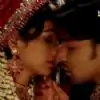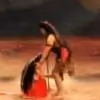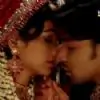Maha Mrityunjaya Mantra
Maha Mrityunjaya Mantra, the powerful mantra of Lord Shiva is a call for enlightenment. Chanting of this mantra purifies the karmas of the soul at a deep level. The Maha Mrityunjaya Mantra (Mantra of Great Victory Over Death) is one of the most ancient mantras well known in the Vedic canon.
The Maha Mrityunjaya Mantra is a life-giving mantra (sanjivini mantra). It is a mantra that is said to rejuvenate, bestow health, wealth, long life, peace, prosperity and contentment. It wards off death and accidents of all descriptions. Besides, it has a great curative power. It is also known as Moksha mantra.

Rigveda Verse: mandala-7 sukt-59 mantra-12 | Rishi: Vashistha | Mantra Devata: Rudra"om tryambhakam yajamahe, sugandhim pushtivardhanam,
urvarukamiva bandhanan, mrityor mukshiya maamritat."
"O praise to the Three-Eyed One, who increases prosperity, who has a sweet fragrance, who frees the world from all disease and death ' liberate me, as the cucumber is easily severed from the vine. O Shiva, grant me immortality!"
Penance for the Mantra
The Mahamrityunjaya mantra was taught by Lord Shiva to Sukracharya, the preceptor of the demons after he succeeded in the impossible test of hanging upside down from a tree for twenty years (Vimsottari dasa period) with smoke blowing into him from a fire lit beneath. Even Brihaspati was shocked at the prospect of such a terrible penance and calmly settled to observe Sukracharya accept the challenge of Indra and succeed.
After the penance Lord Shiva taught the Mahamrityunjaya mantra to Sukracharya, who under very compelling circumstances had to teach this to the son of Brihaspati and that is how the devas also got the mantra. This mantra was given (sruti) to Vasistha Maharishi for the welfare of this world. The mantra and explanation given by Sukracharya to Rishi Dadhicha when the latter's body was cut and thrown by Raja Kshuva is recorded in the Shiva Purana.
What is the meaning of Maha Mrityunjaya Mantra?

OM

Om is the absolute reality. It is said to be "Adi Anadi", without beginning or the end and embracing all that exists. Om is beyond any limit, transcendental, and indestructible. OM represents the wholeness of the universe and the eternal vibratory sound of brahman (the universal soul) that permeates it. Indeed, Om is called shabdabrahman, the sound-form of brahman. Om is a mystical or sacred syllable. The syllable is taken to consist of three phonemes, a, u and m, variously symbolizing the Three Vedas or the Hindu Trimurti or three stages in life (birth, life and death ). A-U-M represents the divine energy (Shakti) united in its three elementary aspects: Bhrahma Shakti (creation), Vishnu Shakti (preservation) and Shiva Shakti (liberation).
In upanishads and sutra:
Om consists of the three sounds a (a-kara), u (u-kara), m (ma-kara). A-kara means form or shape like earth, trees, or any other object. U-kara means formless or shapeless like water, air or fire. Ma-kara means neither shape nor shapeless (but still exists) like the dark matter in the Universe. When we combine all three syllables we get AUM which is a combination of A-kara, U-kara, and Ma-kara.
According to the Mandukya Upanishad
Om is both atman and brahman: it is the past, the present and the future, as well as all that transcends time.
In Purana
Aum or Om is the mystic name for the Hindu Trimurti, and represents the union of the three gods, viz. a for Brahma, u for Vishnu and m for Mahadev which is another name of Shiva. The three sounds also symbolize the three Vedas (Rigveda, Samaveda, Yajurveda).
Om is the mantra of assent. It means yes and affirms and energizes whatever we say after it. That is why all mantras begin with OM. OM is also the mantra of ascent and causes our energy to rise upward into the infinite. By reciting Om, a person gains access to the powers of the universe; and meditation on Om is said to lead to enlightenment and immortality. OM is expansive and increases the fire, air and ether elements, particularly ether. It also gives strength, protection and grace.
Tryambakam

Tryambak = trya + amba = three amba
'Three Amba' are the three Shaktis (the power) signifyin
''will power' (iccha shakti)
power of work' (kriya shakti)
power of wisdom (gyana shakti).
These three shaktis are the creators of this whole world, and the one who has these three is called tryambak.
Tryambak also refers to the three eyes of shiva as 'Trya' means 'Three' and 'Ambakam' means eyes. Three eyes of shiva also refer to fire, sun and moon.Maharshi Kapil defines these eyes as sattva, raja and tamo guna. So we can say that the one who is beyond all gunas is tryambak.
According to Astrologers, past, present and future are the eyes of the mahakaal tryambak. Thus it can be said that the one who exists in past, future and present,and is omniscient, omnipresent and omnipotent is tryambak.
In vedanta - chitta, ego and buddhi are the three eyes of Shiva. Yogis define 'A', 'U' and 'M' as eyes of shiva. Tryambak is the father of the three worlds - bhu, bhuva and svarga lokas (planes of existence). He is the lord of the three heavens created by the dominance of the three Gunas - Rajas, Satva and Tamas.
Yajamahe

By chanting the Maha Mrityunjaya Mantra we surrender to Lord Trayambak establishing a connection with Him. Here the root yaja means to sacrifice for the communion with divinity and yajamahe means 'performing yagya'. Yagya is the tradition that follows from the Vedas. It is the act of offering oblations to propitiate a deity. Thus Yajamahe refers to the desire to make a connection with the lord who is the origin of light, nectar and life by sacrificing and offerings (havan samagri).
Sugandhim

'Sugandhim' refers to the fragrance of the flower that spreads in all directions. Similarly, He - The Supreme God is present in all the bhutas (modes of existence), in the three Gunas (nature of creation as being Satva, Rajas or Tamas), in the ten indriyas (five gyana-indriyas or senses and five karma-indriyas or organs of action), in all the devas (33 devas are the source of all illumination and enlightenment) and the ganas (hosts of demi-gods), He exists and pervades as the illumine atma (soul) and is their essence. He is spreading His fragrance all around and making us as fragrant as He is. Fragrance refers to the joy within Him. we all are bathing in His Fragrance, the real joy. Our self is true and pure as He is. No one can deteorite the true self.
Pustivardhanam

Pushti + vardhnam = pushtivardhanam
Tantric refers pushti as Shakti, In puranic language pushti is maya-( ). Philosphers (tatva chintak) refers it as 'Nature'. Thus, here pushti indicates the shakti- the power - the nature and the one who expands/ enhances the pushti is called pustivardhanam. The one who transforms subtle forms into gross forms and expands the nature into many new forms by his creation is God. God is the sustainer of all beings who has created the entire creation starting from mahatatva (primordial state of matter/energy) to the individual parts. He is the sustainer of the world, the father of all.
Urvarukamiv Bandhnan

We bound by many diseases (approx 100 are in vedas) influenced (negative) by three doshas (imbalance of five elements earth, space, air, water and fire), fear of death, eight type of Agyana (ignorance) and the cycle of birth and death. We are living in the falsehood and are unable to perceive the all pervading God. We are bound by shadripu, the six demons of attachment, lust, greed, ego, anger and
Mrityormukshiya Ma Amritat

O God I wish to be free from the all negativities and to be in real joy. Please take me out of all weakness and the never ending cycle of birth and death. Free me from the fear of diseases and death for the sake of immortality (Moksha, Nirvana or final emancipation from re-birth).
ma amritat means 'please give me some Amritam (life rejuvinating nectar). It means that we are praying for some 'Amrit' to get out of the death inflicting diseases as well as the cycle of re-birth. and to be one with the supreme being, Shiva in the same way as the cucumber fruit (urvaru) gets separated from its stalk.
Edited by BhartiKhushi909 - 13 years ago
















































